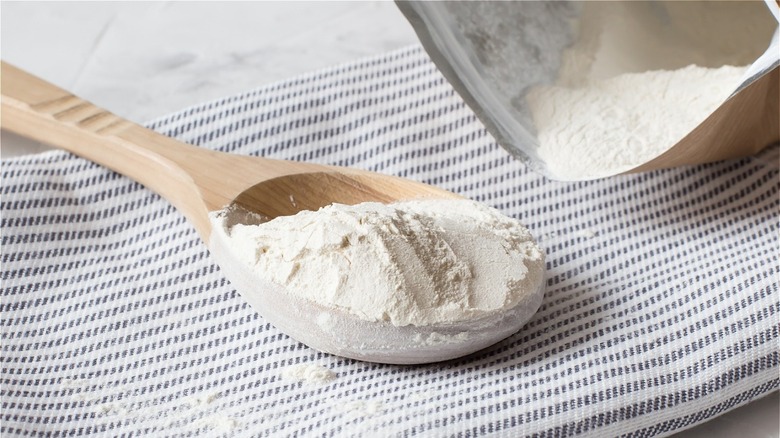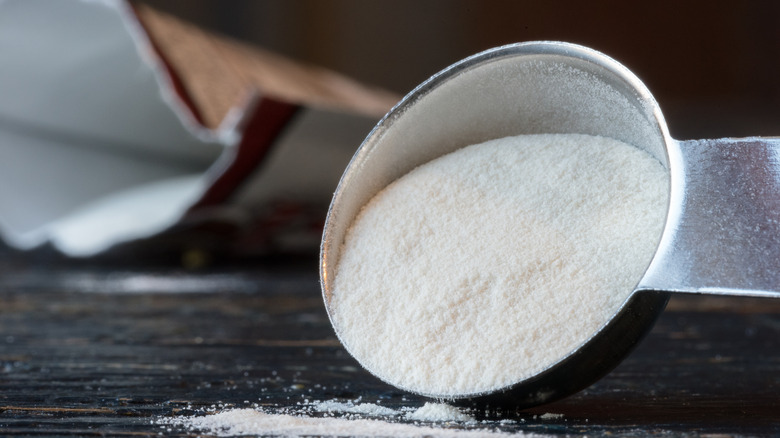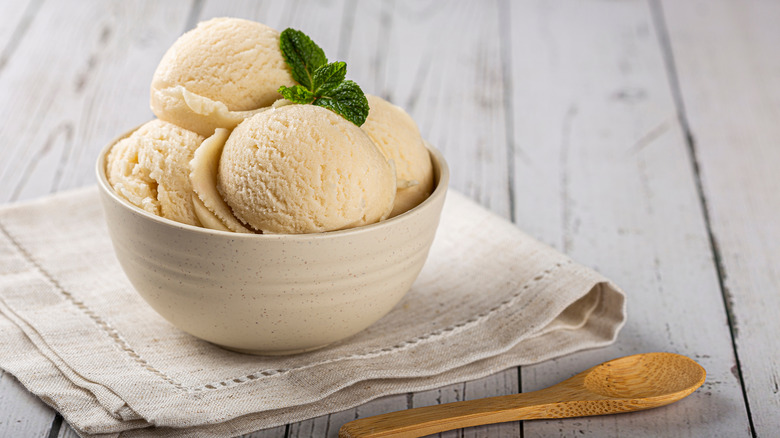The Real Reason There's Xanthan Gum In Ice Cream
Ice cream is arguably the most recognizable and iconic dessert imaginable. Xanthan gum is an additive that might seem ubiquitous due to its growing popularity. Would it surprise you to know that they often go hand-in-hand? To understand why that is, let's start by talking about a classic ice cream ingredient that xanthan gum sometimes replaces.
Traditionally, ice cream combines sugar, milk or cream, flavorings, additives, and mix-ins. And let's not forget eggs. As noted by Serious Eats, egg yolks have long been a staple of ice cream recipes, helping to shape the frozen treat in multiple ways. To get into the scientific nitty-gritty, egg yolks make ice cream thicker, thanks to their lecithin content. Playing the role of emulsifier, they help fat and water form a creamy combo. Furthermore, the sunny side of eggs has a protein structure that helps keep water crystals at bay, which keeps the texture smoother.
Cooks Illustrated says that eggs are often used as a thickener. But recipes for ice creams, puddings, etc., usually call for tempering. Incredible Egg explains that tempering brings together hot mixtures and raw eggs through a process of whisking and gradual blending that – when done properly – doesn't cook the eggs. Xanthan gum, on the other hand, is a very different animal. In fact, it's not really an animal, mixes without heat (as seen in this Food & Wine recipe), and impacts ice cream in a different way.
Xanthan gum works as a stabilizer
To get a sense of how xanthan gum (as well as other gums) factor into ice cream-making, it helps to know that, generally speaking, xanthan gum serves as a stabilizer while egg yolks act as emulsifiers. Dairy Foods notes that emulsifiers affect fats in foods. Meanwhile, stabilizers have more of an impact on water. Eggs provide stability, too, but as emulsifiers, they help to control the smoothness and body of ice cream. Xanthan gum and other stabilizers help the ice cream keep its texture by limiting the movement of water reducing crystal formation. It should also be noted that some cream recipes, like this one from King Arthur Baking, might incorporate xanthan gum and egg yolks. And some brands, such as Ben & Jerry's, might use both egg yolks and guar gum. So don't feel as though this is 100% a "one or the other" type situation.
Dream Scoops states that gums are so powerful that you only need to use a tiny amount: between 0.1 and 0.5% "of the base mixture." A little goes a long way. The site warns that gums can clump if added at the wrong point in the ice cream-making process. Ice Cream Geek also notes that incorporating too much xanthan gum into your ice cream base can actually produce a less-than-ideal product that is reportedly "chewy" and "pudding-like," so beware to use the proper amounts when making ice cream at home.
How xanthan gum makes ice cream more enjoyable
A product of glucose fermentation, xanthan gum arrived in the 1960s, according to The Kitchn. It is used in a host of household items, from toothpaste and salad dressing. Because xanthan gum isn't an animal byproduct, it can be used in dairy-free and vegan ice creams. The Kitchn also points out that xanthan gum makes foods creamier and gives and improves their mouthfeel. For many, there's now no need for the typical egg tempering procedure that may have beleaguered scores of home cooks with homemade ice cream aspirations.
Uber-popular ice cream retailer Salt & Straw also recommends using xanthan gum in ice cream. The "Salt & Straw Ice Cream Cookbook" emphasizes that every single recipe contains xanthan gum. The writers explain, "Xanthan gum has one vital purpose at Salt & Straw: We use it to combat heat shock." Because it immobilizes water, it prevents the crystal formation that would otherwise occur more easily as the ice cream melts and gets re-frozen. The book also contends that homemade ice cream made with xanthan gum has a much longer lifespan in the freezer than traditional homemade ice creams.
Can't get your hands on any xanthan gum but want to go egg-free in your next homemade ice cream recipe? This Food52 piece claims that the common pantry staple cornstarch actually helps to produce the "silkiest" ice creams. It also observes that Jeni's Splendid Ice Cream incorporates cornstarch and cream cheese rather than eggs.
Xanthan gum can improve Philadelphia-style ice cream
Not all traditional ice creams contain eggs. Case-in-point: Philadelphia style ice cream, which also goes by American or New York style, according to TASTE. Viewed as an alternative to the "custardy" French style of the frozen dessert, the eggless Philadelphia style became more prominent in ice cream parlors throughout the Northeastern U.S. Serious Eats says that it is much quicker to make at home. A separate Serious Eats piece adds that the heaviness of an eggy base can take away from the other flavors. Philadelphia-style ice cream can be more flavor-forward, interestingly enough.
But according to Food52, the eggless ice cream is icier as well. This also connects with the oft-maligned freezer burn, which can send a delicious batch of ice cream into nearly inedible territory. Per Healthline, freezer burn can occur when food has sat frozen for a lengthy stretch of time, changing the flavor and creating unappealing ice crystals. It's suggested that homemade Philidelphia-style ice cream be served immediately. But during a video segment with The New York Times (via YouTube), Salt & Straw co-founder Tyler Malek explained that xanthan gum can create a creamy, stable, completely eggless ice cream that can achieve "a Wendy's Frosty texture" with the help of machine-based mixing. The Ben & Jerry's website also lists a slew of tricks to help ameliorate ice cream freezer burn, many of which are simple changes that will help prolong the longevity of your ice cream.



